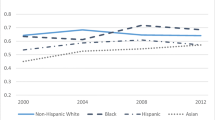Conclusion
We found that there are indeed some slight differences in the electoral behavior of black voters when we separate them into high and low socio-economic areal categories based on the level of median income. These slight differences include turnout rates for primary and general elections and voter registration rates. The higher the socioeconomic status of the black electorate in Boston, the higher the turnout and registration rates for that area tended to be; however, this relationship was not found to be consistent among all the areas selected for study. Despite these differences in electoral behavior or “practices,” our areal model does not suggest any significant political schisms based on the sicioeconomic indicators used. Black voters tended to vote the same way on a number of city and state ballot questions, support the same candidates at both the city and state level, and vote the liberal preference on both issues and candidates regardless of socioeconomic background. In addition, there is some evidence that the higher a black voter is on the socioeconomic scale, the greater his or her tendency will be to vote the liberal position on various issues and candidates. Our model also suggests that black voters will tend to support black candidates regardless of some socioeconomic factors. If this model can be used as an indication of class differences in the black community, then our data show that socioeconomic criteria are not as salient as race in determining the political behavior and preferences of black voters.
Similar content being viewed by others
Notes
William J. Wilson,The Declining Significance of Race (Chicago: University of Chicago Press, 1977).
See William J. Wilson, op. cit. ; Richard Freeman,The Black Elite (New York: Carnegie Foundation, 1976); and Thomas Sowell,Race and Economics (New York: David McKay Co., Inc. 1972).
Adelaide Hill,The Negro Upper Class in Boston (Ph.D. diss., Radcliffe College, 1952).
Manning Marable,From the Grassroots (Boston: South End Press, 1980) p. 224.
Ibid., p. 224.
Michael K. Marshall, “Community Control of Schools in Boston: Prelude to a New Pluralism” (Senior thesis, Harvard University, 1969), p. 11.
Norman I. Fainstein and Susan S. Fainstein,Urban Political Movements: The Search for Power by Minority Groups in American Cities (New Jersey: Prentice-Hall, Inc., 1974), p. 3.
Charles V. Hamilton, “Race and Class in American Politics” (Lecture delivered at Columbia University School of Journalism, October 9, 1978).
Interview with Byron Rushing, president of the Museum of Afro-American History in Boston, Massachusetts, on July 22, 1980.
Mel King was a black state representative who ran for the mayoralty in the fall of 1979; the first black candidate to run for this office was City Councilman Thomas Atkins in 1971.
Bay State Banner, September 12, 1980.
The data presented here is compiled from the U.S. Bureau of the Census, Census of Population and Housing: 1970Census Tracts Final Report PHC (1)-29, Boston Mass. SMSA and Annual Reports of the Department of Elections, Boston, Massachusetts.
Richard P. Runyon and Audrey Haber,Fundamentals of Behavioral Statistics (Reading, Mass.: Addison-Wesley Publishing Co., 1972) and William Mendenhall, Lyman Ott, and Richard F. Larson,Statistics: A Tool for the Social Sciences (North Scituate, Mass.: Duxbury Press, 1974).
Donald Mathews and James Prothro, “Social and Economic Factors and Negro Voter Registration in the South,”American Political Science Review, March 1963, p. 26.
Harlan Hahn, David Klingman, and Harry Pachon, “Cleavages, Coalitions, and the Black Candidate: The Los Angeles Mayoralty Elections of 1969 and 1973,” in Harlan Hahn and Charles Levine,Urban Politics: Past, Present and Future. (New York: Longman, 1980), p. 155. See the following for an additional explanation of this methodology: Harold F. Goldsmith and Elizabeth L. Unger,Social Areas: Identification Procedures Using 1970 Census Data. This study was published by the Mental Health Study Center, National Institute of Mental Health (NIMH) in May 1972.
The median income for all black families in the United States was $6,279 in 1970. U.S. Bureau of the CensusSocial and Economic Characteristics of the Black Population, 1972 Current Population Reports, Series P-60 no. 85 (December 1972).
Charles V. Hamilton, “Race and Class in American Politics” (Lecture delivered at Columbia University School of Journalism, October 9, 1978).
Ibid. p. 8.
Hahn, op. cit., p. 158.
Ibid., p. 158.
A number of works have found evidence of strong rerlationships between the class backgrounds and the political behavior of Americans. See the following: Eulau Heinz, “Perceptions of Class and Party in Voting Behavior: 1952,”American Political Science Review, June 1955; Angus Campbell et al.,The American Voter (New York: Wiley, 1960); Robert E. Lane,Political Life (New York: The Free Press, 1959); Sidney Verba and Norman H. Nie,Participation in America: Political Democracy and Social Equality (New York: Harper and Row, 1972); Lester Milbraith,Political Participation (Chicago: Rand McNally, 1965); Seymore Lipset,Political Man (Garden City, New York: Doubleday, 1960).
About this article
Cite this article
Jennings, J. Race, class, and politics in the black community of Boston. Rev Black Polit Econ 12, 47–63 (1982). https://doi.org/10.1007/BF02903925
Issue Date:
DOI: https://doi.org/10.1007/BF02903925




